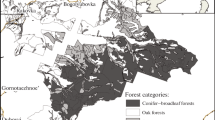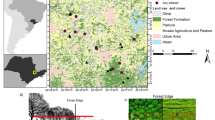Abstract—
Changes in the state of herb–dwarf shrub layer near forest boundaries (the edge effect) were evaluated in anthropogenically fragmented southern taiga pine forests of the Middle Urals. Studies were performed in suburban forests of the Yekaterinburg urban agglomeration on 14 transects perpendicular to the forest edge that extended from it to the inner forest. The transects were 110–260 m long, each consisting of a series of six to nine 400-m2 plots. An increase of species richness in the edge zones of suburban forests was observed for almost all plant groups of the herb–dwarf shrub layer, except for spore plants. The edge effect was expressed most strongly in nonforest, alien, and annual or biennial species. The total projective cover of the herb–dwarf shrub layer increased from the edge to the inner forest zone, while species diversity estimated by the Shannon index remained unchanged. A nonthreshold edge effect was observed for some parameters; i.e., their values monotonically increased or decreased over the entire transect length. In parameters where the depth of edge effect was possible to estimate, it varied from 13 to 64 m, averaging 41 m. In general, the edge effect on the herb–dwarf shrub layer in suburban forests was expressed to the same extent as in urbanized forests.



Similar content being viewed by others
REFERENCES
Harper, K.A., Macdonald, S.E., Burton, P.J., et al., Edge influence on forest structure and composition in fragmented landscapes, Conserv. Biol., 2005, vol. 19, no. 3, pp. 768–782.
Guirado, M., Pino, J., and Roda, F., Understory plant species richness and composition in metropolitan forest archipelagos: Effects of forest size, adjacent land use and distance to the edge, Glob. Ecol. Biogeogr., 2006, vol. 15, pp. 50–62.
Laurance, W.F., Nascimento, H.E.M., Laurance, S.G., et al., Habitat fragmentation, variable edge effects, and the landscape-divergence hypothesis, PLoS One, 2007, vol. 2, no. 10, e1017. https://doi.org/10.1371/journal.pone.0001017.13
Marozas, V., Effect of the coniferous forest–grassland edge on ground vegetation in the mixed European forest zone, Lithuania, Dendrobiology, 2014, vol. 71, pp. 15–22.
Laurance, W.F., Laurance, S.G., Ferreira, L.V., et al., Biomass collapse in Amazonian forest fragments, Science, 1997, vol. 278, no. 5340, pp. 1117–1118.
McDonald, R.I. and Urban, D.L., Forest edges and tree growth rates in the North Carolina Piedmont, Ecology, 2004, vol. 85, no. 8, pp. 2258–2265.
Sampaio, A.B. and Scariot, A., Edge effect on tree diversity, composition and structure in a deciduous dry forest in central Brazil, Rev. Arvore, 2011, vol. 35, no. 5. https://doi.org/10.1590/S0100-67622011000600018
Ziter, C., Bennett, E.M., and Gonzalez, A., Temperate forest fragments maintain aboveground carbon stocks out to the forest edge despite changes in community composition, Oecologia, 2014, vol. 176, no. 3, pp. 893–902.
Ibáñez, I., Katz, D.S.W., Peltier, D., et al., Assessing the integrated effects of landscape fragmentation on plants and plant communities: The challenge of multiprocess–multiresponse dynamics, J. Ecol., 2014, vol. 102, no. 4, pp. 882–895.
Suarez-Esteban, A., Fahrig, L., Delibes, M., and Fedriani, J.M., Can anthropogenic linear gaps increase plant abundance and diversity?, Landsc. Ecol., 2016, vol. 31, no. 4, pp. 721–729.
Weathers, K.C., Cadenasso, M.L., and Pickett, S.T., Forest edges as nutrient and pollutant concentrators: Potential synergisms between fragmentation, forest canopies, and the atmosphere, Conserv. Biol., 2001, vol. 15, no. 6, pp. 1506–1514.
Kelcey, J.G. and Muller, N., Plants and Habitats of European Cities, New York: Springer, 2011.
Kowarik, I., Lippe, M., and Cierjacks, A., Prevalence of alien versus native species of woody plants in Berlin differs between habitats and at different scales, Preslia, 2013, vol. 85, no. 2, pp. 113–132.
Blood, A., Starr, G., Escobedo, F., et al., How do urban forests compare? Tree diversity in urban and periurban forests of the southeastern US, Forests, 2016, vol. 7, Art. 120. https://doi.org/10.3390/f7060120
Pauchard, A. and Alaback, P.B., Edge type defines alien plant species invasions along Pinus contorta burned, highway and clearcut forest edges, For. Ecol. Manag., 2006, vol. 223, nos. 1–3, pp. 327–335.
Eldegard, K., Totland, Ø., and Moe, S.R., Edge effects on plant communities along power line clearings, J. Appl. Ecol., 2015, vol. 52, pp. 871–880.
Deljouei, A., Abdi, E., Marcantonio, M., et al., The impact of forest roads on understory plant diversity in temperate hornbeam–beech forests of northern Iran, Environ. Monit. Assess., 2017, vol. 189, no. 8, p. 392.
Hamberg, L., Lehvavirta, S., Malmivaara-Lamsa, M., et al., The effects of habitat edges and trampling on understorey vegetation in urban forests in Helsinki, Finland, Appl. Veg. Sci., 2008, vol. 11, no. 1, pp. 83–86.
LaPaix, R., Harper, K., and Freedman, B., Patterns of exotic plants in relation to anthropogenic edges within urban forest remnants, Appl. Veg. Sci., 2012, vol. 15, no. 4, pp. 525–535.
Vallet, J., Beaujouan, V., Pithon, J., et al., The effects of urban or rural landscape context and distance from the edge on native woodland plant communities, Biodivers. Conserv., 2010, vol. 19, no. 12, pp. 3375–3392.
Ranta, P., Viljanen, V., and Virtanen, T., Spatiotemporal dynamics of plant occurrence in an urban forest fragment, Plant Ecol., 2013, vol. 214, no. 5, pp. 669–683. https://doi.org/10.1007/s11258-013-0198-6
Meng, X.F., Zhang, Z.W., Li, Z., et al., The effects of city–suburb–exurb landscape context and distance to the edge on plant diversity of forests in Wuhan, China, Plant Biosyst., 2015, vol. 149, no. 5, pp. 903–913.
Veselkin, D.V., Korzhinevskaya, A.A., and Podgaevskaya, E.N., The edge effect on the herb–dwarf shrub layer of urbanized southern taiga forests, Russ. J. Ecol., 2018, vol. 49, no. 6, pp. 411–420. https://doi.org/10.1134/S1067413618060139
Pobedin, A.A., Territories of advanced socioeconomic development in Sverdlovsk oblast, Munitsipal. Ekonom. Upravl., 2015, no. 4 (13), pp. 14–29. https://municipality. expert/issue/2015/04/02.
Gosudarstvennyi doklad o sostoyanii i ob okhrane okruzhayushchei sredy Sverdlovskoi oblasti v 2019 godu (State Report on the Status and Protection of the Environment in Sverdlovsk Oblast in 2019), Yekaterinburg, 2020.
Gorchakovskii, P.L., Nikonova, N.N., and Famelis T.V., The Phytoecological map as a means for evaluating the state and anthropogenic transformation of vegetation, Russ. J. Ecol., 2000, vol. 31, no.6, pp. 379–385.
Shavnin, S.A., Galako, V.A., Menshchikov, S.L., et al., Silvicultural assessment of the ecological state of forests exposed to recreational and technogenic pollution, Izv. Orenburg. Gos. Agr. Univ., 2010, no.3 (27), pp. 37–41.
Veselkin, D.V., Vorobeichik, E.L., Galako, V.A., et al., Relationship between the characteristics of the state of Scots pine trees and tree stands in a large industrial city, Contemp. Probl. Ecol., 2015, vol. 8, no. 2, pp. 243–249.
EUNIS Habitat Classification Descriptions. https:// www.eea.europa.eu/data-and-maps/data/eunis-habitat-classification. Accessed April 20, 2021.
Kulikov, P.V., Zolotareva, N.V., and Podgaevskaya, E.N., Endemichnye rasteniya Urala vo flore Sverdlovskoi oblasti (Endemic Plants of the Urals in the Flora of Sverdlovsk Oblast), Yekaterinburg: Goshchitskii, 2013.
Lesorastitel'nye usloviya i tipy lesov Sverdlovskoi oblasti: prakticheskoe rukovodstvo (Site Conditions and Forest Types in Sverdlovsk Oblast: A Manual), Kolesnikov, B.P., Zubareva, R.S., and Smolonogov, E.P., Eds., Sverdlovsk: Ural. Nauch. Tsentr Akad. Nauk SSSR, 1973.
Pogodina, G.S. and Rozov, N.N., Pochvy, Ural i Priural’e. (Soils of the Urals and Transural Region), Moscow: Nauka, 1968, pp. 168–210.
Atlas Sverdlovskoi oblasti (Atlas of Sverdlovsk Oblast), Yekaterinburg: Roskartografuya, 1997.
WCVP 2021: World Checklist of Vascular Plants, version 2.0. Facilitated by the Royal Botanic Gardens, Kew. http://wcvp.science.kew.org/ Accessed May 21, 2021.
Villasenor, N.R., Blanchard, W., and Lindenmayer, D.B., Decline of forest structural elements across forest urban interfaces is stronger with high rather than low residential density, Basic Appl. Ecol., 2016, vol. 17, no. 5, pp. 418–427.
Guerra, T.N.F., Araujo, E.L., Sampaio, E.V.S.B., et al., Urban or rural areas: Which types of surrounding land use induce stronger edge effects on the functional traits of tropical forests plants?, Appl. Veg. Sci., 2017, vol. 20, pp. 538–548.
Hamberg, L., Lehvavirta, S., and Kotze, D.J., Forest edge structure as a shaping factor of understorey vegetation in urban forests in Finland, For. Ecol. Manag., 2009, vol. 257, no. 2, pp. 712–722.
Krasnaya kniga Sverdlovskoi oblasti: zhivotnye, rasteniya, griby (The Red Data Book of Sverdlovsk Oblast: Animals, Plants, and Fungi), Korytin, N.S., Ed., Yekaterinburg: OOO Mir, 2018.
Tishler, A. and Zang, I., A new maximum-likelihood algorithm for piecewise regression, J. Am. Stat. Assoc., 1981, vol. 76, pp. 980–987.
Toms, J.D. and Lesperance, M.L., Piecewise regression: A tool for identifying ecological thresholds, Ecology, 2003, vol. 84, no. 8, pp. 2034–2041.
Eigenbrod, F., Hecnar, S.J., and Fahrig, L., Quantifying the road-effect zone: Threshold effects of a motorway on anuran populations in Ontario, Canada, Ecol. Soc., 2009, vol. 14, no. 1, Art. 24.
ACKNOWLEDGMENTS
The authors are grateful to D.I. Dubrovin (Institute of Plant and Animal Ecology, Ural Branch, Russian Academy of Sciences) and E.N. Kokshina (Ural Federal University) for their help in field research and to N.V. Zolotareva (Institute of Plant and Animal Ecology, Ural Branch, Russian Academy of Sciences) for her help in identification of plant species.
Funding
Field measurements were made under state contract with Institute of Plant and Animal Ecology, Ural Branch, Russian Academy of Sciences (no. AAAA-A19-119031890084-6); data analysis was supported by the joint project of the Russian foundation for Basic Research and Belarusian Republican Foundation for Fundamental Research (no. 20-54-00024 Bel_a).
Author information
Authors and Affiliations
Corresponding author
Ethics declarations
The authors declare that they have no conflict of interest.
Additional information
Translated by N. Gorgolyuk
Rights and permissions
About this article
Cite this article
Veselkin, D.V., Korzhinevskaya, A.A. & Podgaevskaya, E.N. The Edge Effect on the Herb–Dwarf Shrub Layer of Suburban Anthropogenically Fragmented Southern Taiga Pine Forests. Russ J Ecol 52, 446–454 (2021). https://doi.org/10.1134/S106741362106014X
Received:
Revised:
Accepted:
Published:
Issue Date:
DOI: https://doi.org/10.1134/S106741362106014X




